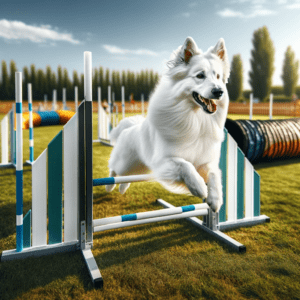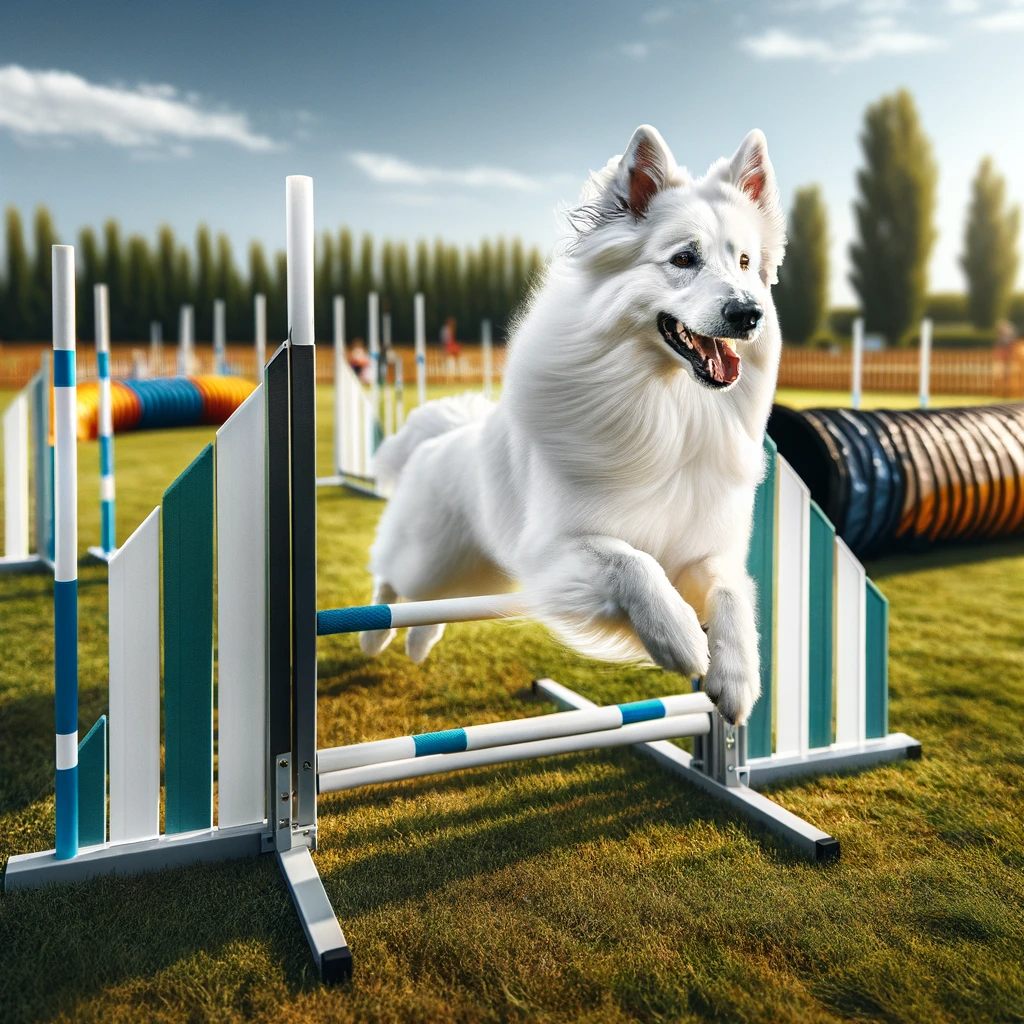Are you considering introducing a White Swiss Shepherd to agility courses? You may be wondering if there are any specific challenges to be aware of. Well, the good news is that while White Swiss Shepherds can excel in agility, there are a few factors that may require some extra attention. From their unique temperament to their physical capabilities, understanding the potential challenges can help ensure a smooth and successful introduction to agility courses for your beloved White Swiss Shepherd.
Preparation
Assessing the Dog’s Physical Fitness
Before starting any agility training, it’s important to assess your White Swiss Shepherd’s physical fitness. This is crucial because agility requires a dog to have strength, stamina, and coordination. You can assess your dog’s physical fitness by observing their overall health, energy levels, and willingness to engage in physical activity. If your dog is generally healthy and active, they are likely to be physically fit for agility training. However, if you have any concerns about your dog’s fitness, it’s always a good idea to consult with your veterinarian.
Building Basic Obedience Skills
In order to participate in agility courses effectively, your White Swiss Shepherd should have a solid foundation of basic obedience skills. These skills include commands such as sit, stay, come, and heel. Building these basic obedience skills is essential for your dog’s safety and for the overall success of their agility training. By establishing a strong obedience foundation, you can ensure that your dog will be able to listen to your commands and follow instructions during agility courses.
Introducing Basic Agility Equipment
Once your White Swiss Shepherd has a good level of physical fitness and has mastered basic obedience skills, it’s time to introduce them to basic agility equipment. Start with simple obstacles such as a tunnel or a low hurdle. Allow your dog to explore the equipment at their own pace, always using positive reinforcement and rewards to create a positive association. Gradually increase the difficulty level of the obstacles as your dog becomes more comfortable and confident. Introducing basic agility equipment in a positive and gradual manner will help your dog build their skills and confidence for more challenging agility courses.
Temperament Considerations
Understanding the White Swiss Shepherd’s Nature
Understanding the nature of the White Swiss Shepherd is crucial when training them for agility courses. These dogs are known for their intelligence, loyalty, and eagerness to please their owners. They are generally friendly and sociable but can be reserved with strangers. Take into consideration their natural traits when designing their training program. By understanding the temperament of your White Swiss Shepherd, you can adjust the training techniques and methods to suit their individual needs.
Evaluating the Dog’s Confidence Level
Confidence plays a significant role in a dog’s ability to excel in agility courses. Evaluate your White Swiss Shepherd’s confidence level and tailor the training accordingly. If your dog is naturally confident, they may be more willing to tackle new obstacles and challenges. However, if your dog is shy or anxious, they may need a more gradual approach to build their confidence. Patience and positive reinforcement are key when working with a less confident dog, as it will help them gain trust and overcome their fears.
Working with Shy or Anxious Dogs
White Swiss Shepherds, like any other breed, may have individual dogs that are shy or anxious. It’s important to approach training with these dogs with extra care and sensitivity. For shy dogs, start with smaller and less intimidating obstacles, gradually building up their confidence. Use positive reinforcement, such as treats and praise, to reward their progress. With anxious dogs, it can be helpful to incorporate relaxation techniques, such as deep breathing exercises or massage, to help them stay calm during training sessions. Always remember to go at their pace and provide a safe and encouraging environment for them to succeed.
Breed-Specific Challenges
Addressing High Energy Levels
White Swiss Shepherds are known for their high energy levels, which can sometimes present a challenge during agility training. To address this challenge, it’s important to provide regular exercise and mental stimulation for your dog outside of the training sessions. A tired dog is more likely to be focused and attentive during agility training. Incorporating activities such as long walks, interactive play sessions, and puzzle toys can help channel their energy in a positive way.
Dealing with Independent Thinking
White Swiss Shepherds are intelligent dogs with an independent streak, which can make them prone to taking their own initiative during agility courses. While this independent thinking can be an advantage, it can also pose challenges when it comes to following directions or staying focused. To address this challenge, it’s important to establish yourself as the leader and provide clear and consistent communication. Use positive reinforcement techniques to reward your dog for following your cues and instructions, reinforcing that listening to you is rewarding and beneficial.
Overcoming Potential Distractions
Agility courses can be filled with distractions, such as other dogs, noises, and smells. White Swiss Shepherds, being highly observant and sensitive dogs, may find it challenging to stay focused in such environments. Gradually expose your dog to different distractions during training sessions, starting with low-level distractions and gradually increasing the difficulty. Use positive reinforcement to reward your dog for maintaining focus despite distractions. Consistency and patience are key when training your White Swiss Shepherd to overcome potential distractions and stay focused on the agility course.
Training Techniques
Positive Reinforcement
Positive reinforcement is a highly effective training technique that involves rewarding desired behaviors with treats, praise, or play. White Swiss Shepherds respond particularly well to positive reinforcement due to their eagerness to please their owners. Use treats, verbal praise, and physical affection to reward your dog for performing desired behaviors during agility training. Positive reinforcement not only motivates your dog but also strengthens the bond between you and your White Swiss Shepherd.
Clicker Training
Clicker training is a popular and effective training method that utilizes a sound made by a small device called a clicker to mark desired behaviors. White Swiss Shepherds are intelligent and quick learners, making them well-suited to clicker training. Start by associating the sound of the clicker with rewards, and then use the clicker to mark and reinforce desired behaviors during agility training. Clicker training can help create clear communication between you and your dog and increase their understanding of what is expected from them.
Targeting and Directional Cues
Targeting and directional cues are important for guiding your White Swiss Shepherd through agility courses. Teach your dog to follow a target, such as a hand target or a target stick, to direct them towards specific obstacles or positions. Pairing directional cues, such as verbal commands or hand signals, with the target can further enhance your dog’s understanding of where to go and what to do. Consistent and clear targeting and directional cues will help your dog navigate the agility course with precision and confidence.
Obstacle Familiarization
Introducing Different Obstacles
Familiarizing your White Swiss Shepherd with different agility obstacles is an essential part of their training. Start with simple and low-risk obstacles, such as tunnels and jumps, to allow your dog to become comfortable with the equipment. Introduce one obstacle at a time and use positive reinforcement to create a positive association. Take it slow and gradually increase the difficulty by adding more complex and challenging obstacles. Keep in mind that each dog learns at their own pace, so be patient and adapt the training to your dog’s individual needs.
Desensitizing to Specific Obstacle Challenges
Certain agility obstacles may pose specific challenges to your White Swiss Shepherd. For example, your dog may be hesitant to climb a high A-frame or navigate a narrow weave pole. To help your dog overcome these challenges, break down the obstacles into smaller steps and gradually increase their difficulty. Use positive reinforcement and rewards to motivate your dog and build their confidence as they successfully overcome each challenge. Desensitization techniques, such as gradually exposing your dog to the obstacle and rewarding calm behavior, can also be helpful in addressing specific fears or hesitations.
Progressive Training Approaches
Agility training requires a progressive approach to ensure your White Swiss Shepherd’s success. As your dog becomes more comfortable and confident with the basic obstacles, gradually increase the complexity and difficulty of the training exercises. Introduce new obstacles, combine multiple obstacles into sequences, and vary the difficulty level and order of the obstacles. Keep the training sessions stimulating and engaging to maintain your dog’s motivation and interest. Progressive training approaches will help your White Swiss Shepherd build the skills and confidence necessary to tackle more advanced agility courses.
Handling and Communication
Mastering Handler Techniques
As the handler, your role is crucial in guiding and directing your White Swiss Shepherd through agility courses. Mastering handler techniques will improve your ability to effectively communicate with your dog and navigate the course efficiently. Practice clear and precise body language, use voice commands or verbal cues consistently, and maintain a positive and encouraging attitude. Oftentimes, handlers will also need to run alongside their dog during the agility course, so incorporating running or jogging into your training routine can help simulate the speed and movement required.
Developing Clear Communication Signals
Clear communication signals are essential for successful agility training with your White Swiss Shepherd. Consistency is key when it comes to communicating your expectations to your dog. Use consistent hand signals, verbal cues, and body language to direct your dog through the obstacles. It’s important to familiarize your dog with these signals during training and ensure they understand what each signal means. Reinforce the communication signals with positive reinforcement to create a strong connection between your cues and your dog’s responses.
Tailoring Training to Individual White Swiss Shepherds
Each White Swiss Shepherd has its own unique personality and learning style, so it’s important to tailor the training approach to suit their individual needs. Observe how your dog responds to different training techniques and adjust accordingly. Some dogs may thrive with a more energetic and fast-paced training style, while others may require a gentler and more patient approach. By understanding and respecting your dog’s individuality, you can create a training program that is effective and enjoyable for both you and your White Swiss Shepherd.

Building Confidence
Gradual Exposure to Challenging Circumstances
Building confidence is essential for your White Swiss Shepherd to excel in agility courses. Gradual exposure to challenging circumstances is one way to help your dog build their confidence. Start with easier obstacles and gradually progress to more challenging ones. If your dog is hesitant or fearful, break down the challenge into smaller steps and celebrate each small achievement. This approach will allow your dog to build confidence gradually, without becoming overwhelmed or anxious.
Positive Reinforcement for Overcoming Fears
When your White Swiss Shepherd overcomes their fears or hesitations during agility training, it’s important to provide positive reinforcement. Reward them with treats, praise, and play for successfully completing a challenging obstacle or overcoming a fear. Positive reinforcement reinforces the idea that facing fears and challenges leads to positive outcomes, which will further boost your dog’s confidence. Celebrate their achievements and let them know how proud you are of their progress.
Trust-Building Exercises
Building trust with your White Swiss Shepherd is essential for successful agility training. Incorporate trust-building exercises into your training routine to strengthen the bond between you and your dog. These exercises can include activities such as focus games, recall exercises, and partner activities that involve teamwork and cooperation. As your dog learns to trust and rely on you, their confidence will grow, leading to improved performance on the agility course.
Maintaining Motivation
Keeping Training Sessions Fun and Engaging
To maintain your White Swiss Shepherd’s motivation, it’s important to keep the training sessions fun and engaging. Incorporate games, play, and interactive activities into the training routine to make it enjoyable for your dog. Use toys, treats, and praise as rewards to make the training sessions rewarding and exciting. Mixing up the training exercises and introducing new challenges will keep your dog mentally stimulated and motivated to continue their agility training.
Using Rewards and Variety
Using rewards and variety in your White Swiss Shepherd’s training sessions is a great way to maintain motivation. Experiment with different types of rewards, such as high-value treats, favorite toys, or playtime, to keep your dog engaged and excited. Vary the training exercises, obstacles, and sequences to avoid monotony and keep your dog’s interest level high. By incorporating rewards and variety, you can ensure that your White Swiss Shepherd remains enthusiastic and motivated during their agility training.
Taking Breaks and Avoiding Burnout
Just like humans, dogs can experience burnout from excessive training or repetitive tasks. It’s important to take breaks during training sessions and provide your White Swiss Shepherd with regular rest periods. This allows them to recharge and keeps their motivation levels high. Listen to your dog’s cues and be mindful of signs of fatigue or disinterest. Taking breaks and avoiding burnout will help maintain your dog’s enthusiasm and ensure that their agility training remains enjoyable for both of you.
Physical Conditioning
Developing Stamina and Endurance
Participating in agility courses requires your White Swiss Shepherd to have both stamina and endurance. To develop these qualities, incorporate regular cardio exercises into your dog’s routine. Activities such as long walks, jogging, or hiking can help improve their cardiovascular fitness. Gradually increase the duration and intensity of these exercises to build their stamina and endurance. Regular physical conditioning will ensure that your White Swiss Shepherd has the energy and endurance necessary to perform well on agility courses.
Strength Training for Jumping and Climbing
Agility courses often involve jumping and climbing obstacles, which require your White Swiss Shepherd to have adequate strength. Incorporate strength training exercises such as targeted muscle workouts and obstacle-specific drills into your dog’s training routine. Exercises such as balance exercises, jumping exercises, and climbing exercises can help build the necessary muscle strength. Always consult with a professional trainer or veterinarian before starting any strength training regimen for your dog to ensure their safety and well-being.
Balancing Exercise with Rest and Recovery
While physical conditioning is important for your White Swiss Shepherd’s agility training, it’s equally important to balance exercise with rest and recovery. Intense training sessions should be followed by rest days to allow your dog’s muscles to recover and prevent overexertion. Provide a comfortable and quiet space for your dog to rest and recharge. Adequate rest and recovery will help prevent injuries and ensure that your White Swiss Shepherd stays fit and healthy for their agility training.
Conclusion
Introducing a White Swiss Shepherd to agility courses can be a rewarding and enjoyable experience for both you and your dog. By following the preparation steps, considering their temperament, addressing breed-specific challenges, using effective training techniques, familiarizing them with obstacles, honing your handling skills, building confidence, maintaining motivation, and focusing on their physical conditioning, you can help your White Swiss Shepherd become a skilled and confident agility competitor. Remember to always approach the training process with patience, positivity, and understanding, and you will have a great time bonding and achieving agility success with your beloved White Swiss Shepherd.

